FAQ's in Printing
- > What type of files can I upload/send to LeCards?
- > What color mode should my files be?
- > What resolution should my file(s) be?
- > How should I setup my design's bleed, etc?
- > How can I have rich black print?
- > How can I prevent royal blue from printing purple?
- > How should I setup a SPOT UV / FOIL job?
- > How do I setup my plastic business cards?
- > What are the file requirements for NCR Forms? Can I have full bleed?
- > What is Gloss UV Coating and Matte Finish?
- > What is the differences between 14pt, 16pt or other paper card stocks?
- > Why can't you print my color (Pantone, RGB, bright green etc.)?
- > Do you offer color matching?
- > Why does my business card crack around the edges?
- > Why is there some cracking on my scoring job?
- > What is the radius used for round corners?
- > What is EDDM and how do I use it?
- > What is Bundling for EDDM and how does it work?
- > What is 14pt Metallic Pearl Paper?
- > What is 14pt Natural Paper?
- > What are NCR Forms?
- > Do the NCR form come pre-collated? Are they glued in sets?
- > Are NCR Forms printed in full color on each sheet or is the print black ink only?
- > What are NCR forms used for?
Artwork & files
What type of files can I upload/send to LeCards?
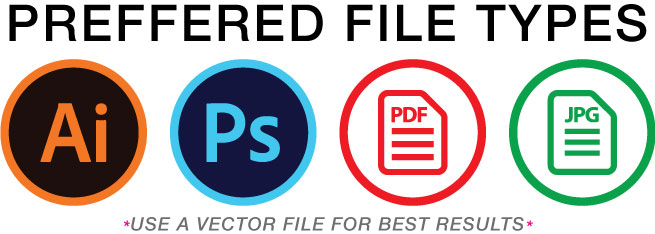
What color mode should my files be?

What resolution should my file(s) be?
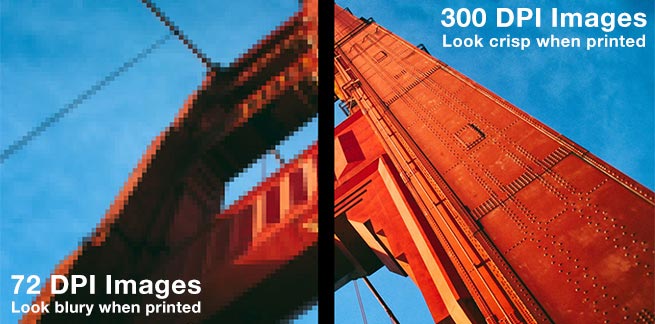
How should I setup my design's bleed, etc?
For BEST results, use our ARTWORK TEMPLATES to have the most accuracy. All important text must stay within the blue safe zone.

How can I have rich black print?

To have rich black colors, make sure to setup your CMYK color codes to:
C 60% M 40% Y 40% K 100%

How can I prevent royal blue from printing purple?
C 100%
M 70%
Y 0%
K 0%
To make the blue darker, just add more % to the K(key) to meet your desired blue.
How should I setup a SPOT UV / FOIL job?
To setup your mask file (SPOT UV or FOIL) we need it to be represented in a black and white format. Black will represent where the finishing will be placed in relevance to the print size while the white will remain untouched. The black should be with the following CMYK color code:
C: 0%
M: 0%
Y: 0%
K: 100%
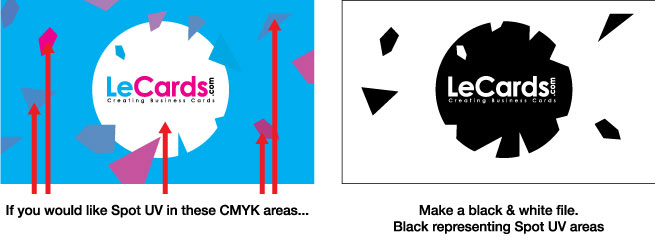
How do I setup my plastic business cards?
REMINDER: Clear business cards are very sensitive and scratch easily, we do our best to prevent them from being scratched by adding a thin removable film on to them so they are scratch-free when you get them.
What are the file requirements for NCR Forms? Can I have full bleed?
- At least 0.25" of space on the glued edge (short edge) should be free of ink
- Full color and solid colored backgrounds are not recommended, as it may effect your ability to read the text and write on the form
- Light ink coverage is highly recommended
What is Gloss UV Coating and Matte Finish?
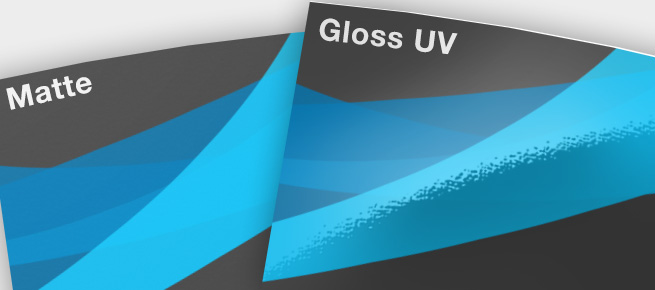
Glossy UV coating is a shiny finish to your marketing materials that will enrich your design and enhance your colors. Glossy UV coatings also protect your marketing materials so they last longer.
Matte finish is a very light coating that provides a boost to the contrast of your photos, but results in very little glare. The matte coating provides a smoother presentation, and softer than the appearance of a glossy sheet. Matte sheets are good for enhancing visual designs with a more subdued layout and color set without having a lot of glare which glossy coatings suffer from.
Spot Gloss UV coating is our premium coating that makes pictures really stand out by coating specified areas with UV gloss. It can enhance color contrast and make vibrant colors pop.
What is the differences between 14pt, 16pt or other paper card stocks?
Cardstock is a thick paper, also known as “cover stock,” and "points" is a measurement of thickness. One unit of thickness equals 1/1000 of an inch, so each point is actually .001 inches thick. Hence, the higher the points, the thicker the paper.
Bookweight paper is the same as 100lb and 100#. 100lb book weight paper is measured in weight. The “100lb” refers to the weight of 500 printer sheets of this paper and is considered a medium “text weight.” Our bookweight paper has a high gloss coating which allows it to perform well on the press for color and detail; however, it is flimsier compared to cardstock and does not stand up well on its own.
100lb Gloss Book is a medium weight paper that can be easily rolled, unlike the more rigid 100lb Gloss Cover. It is coated on both sides with Aqueous Coating and is often used for Flyers, Catalogs and Door Hangers.
100lb Gloss Cover (with Aqueous Coating on certain products offered) is similar to the 100lb Gloss Book, but thicker and heavier. It is coated on both sides with Aqueous Coating on some products we offer. Often used for durable, heavy brochures, catalog covers, flyers, door hangers, etc.
14pt ( .014" inch thick) is the standard thickness for business cards postcards, greeting cards, etc. 14pt. is noticeably thicker than 10pt. and slightly thicker than 12pt., with each layer of thickness adding sturdiness and rigidity to the paper.
16pt ( .016" inch thick) is a little thicker (about 15% thicker) and heavier than 14pt. It is appreciated more with a matte finish which will provide a more sharp and vividness, but without the shiny surface. Applying UV-coating, however, will make the product very glossy. This thick card stock is often used for business cards, postcards, rack cards, presentation folders, greeting cards, etc.
FAQ's in Printing
Why can't you print my color (Pantone, RGB, bright green etc.)?
RGB is a screen color display mode – it is not suitable for previewing colors for print. Some colors that can be displayed on screen in RGB cannot be printed in CMYK – fluorescent green is one of these colors.
We accept file in RGB format but the colors will be converted to CMYK in your proof.
Pantone colors require us to use a different machine and create plates specifically to match your order needs. This will incur additional charges. Please call us for more info at 877-677-4800.
Do you offer color matching?
Colors will shift varying amounts between paper stocks and coatings – especially between output on coated paper and uncoated paper. Uncoated paper is used on all our printed envelopes, letterheads, etc..
Unless it's custom pantone printing, which will require custom printing services call 877-677-4800.
Why does my business card crack around the edges?
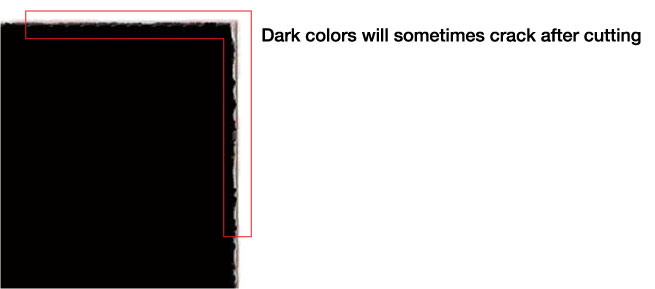
This usually happens on a small amount of cards in the run. To prevent this, use lighter colors or if you must use dark colors, make sure they are files on front side.
Why is there some cracking on my scoring job?
What is the radius used for round corners?
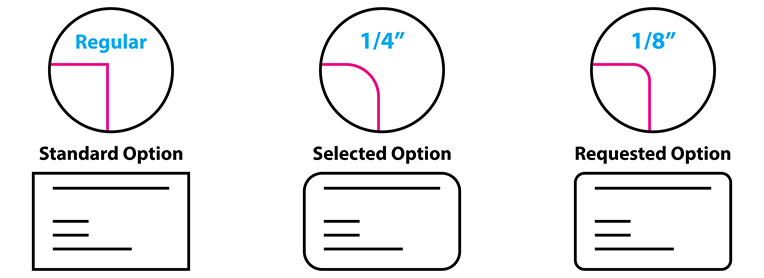
What is EDDM and how do I use it?
For more information on how EDDM works, please visit
https://www.usps.com/business/every-door-direct-mail.htm
NOTE: For all EDDM products, you are responsible for setup and delivery to USPS for EDDM processing.
USPS requirements for EDDM include choosing the area for mailing from the USPS system, bundling the postcards in packs of 50 and labeling each bundle for the preselected route. LeCards.com will not be responsible for these requirements.
We offer the service of taking care of this on your behalf so you do not have to worry about anything for an additional fee. Please contact us at 877-677-4800 for more information.
What is Bundling for EDDM and how does it work?
Please Note:
Processing time for bundling your product may not be included in the turnaround time that you select when placing your order.
Please add 1 to 2 days to your turnaround time for this service.
The type of band we use may vary from time to time subject to availability but will always use material accepted by the postal office.
The maximum quantity offered for bundling is 25,000 pieces.
What is 14pt Metallic Pearl Paper?
Our 14pt Metallic Pearl paper is a unique stock that shimmers in light when viewed from different angles. The stock itself is embedded with Pearl fibers that give the paper an overall smooth, metallic look. Printing on this stock will give your CMYK colors a subtle shimmer, however heavy ink densities or coverage may diminish the effect.
Used mainly for either business cards, post cards or invitations.
What is 14pt Natural Paper?
Mainly used for business cards, post cards or invitations.
What are NCR Forms?
They're available in 2 Part (White, Canary) and 3 Part (White, Canary, Pink) collated sets that are glued on the short edge. NCR Forms are printed on 20LB stock on high tech digital equipment.
Do the NCR form come pre-collated? Are they glued in sets?
Are NCR Forms printed in full color on each sheet or is the print black ink only?
Please check our products for more details on price.


